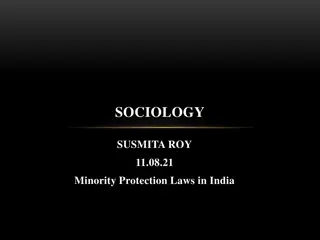Overview of Caste System in India
The caste system in India is a social structure defined by hereditary groups, each with specific occupations, rules, and traditions. Membership is based on birth, leading to a rigid hierarchy and limited mobility between castes. Endogamy, occupation, commensality, and purity are key features that shape inter-caste relationships and status. This system is marked by segmental divisions, hierarchy, endogamy, fixed occupations, and notions of purity and pollution.
Download Presentation

Please find below an Image/Link to download the presentation.
The content on the website is provided AS IS for your information and personal use only. It may not be sold, licensed, or shared on other websites without obtaining consent from the author. Download presentation by click this link. If you encounter any issues during the download, it is possible that the publisher has removed the file from their server.
E N D
Presentation Transcript
CASTE A CASTE MAY BE DEFINED AS A COLLECTION OF FAMILIES OR GROUPS OF FAMILIES BEARING A COMMON NAME WHICH USUALLY DENOTES OR IS ASSOCIATED WITH A SPECIFIC OCCUPATION; CLAIMING COMMON DESCENT FROM A MYTHICAL ANCESTOR, HUMAN AND DIVINE; PROFESSING TO FOLLOW THE SAME CALLING AND FORMING A SINGLE HOMOGENEOUS COMMUNITY.
DEFINATIONS CASTE Sir Herbert Risely Caste is a collection of families, bearing a common name, claiming a common descent, from a mythical ancestor, human and divine, professing to follow the same hereditary calling and regarded by those who are competent to give an opinion as forming a single homogeneous community. Charles Cooley "When a class is somewhat strictly hereditary, we may call it a caste. Kelelkar 'Caste is a social group having two characteristics (a) membership is confined to those who are born of members & includes all persons no born (b) the members are forbidden by an inexorable social law to marry outside the group. Mazumdar & Madan 'Caste is a closed class'
Characteristics of caste system in india: 1.Segmental division So far as caste system is concerned, each caste is an autonomous group independent of the other. Membership in a caste is based on birth. Hence it is unchangeable. For this reason mobility from one caste to another is impossible. Each caste has its own way of life. It has its own rules and regulations, customs, traditions, practices and rituals. It has its own governing body called the caste council to enforce the caste rules. In this way each caste is a social world by itself. 2.Hierarchy The caste system is hierarchical in nature. It comprises four varnas or castes. These in descending order of ranking are Brahmins, Kshatriyas, Vaishyas and Shudras. There are many castes between the two extremes-the Brahmins and the Shudras. Their social status depends upon their distance from the Brahmins.
Endogamy Westermarck regards endogamy as the essence of the caste system. Endogamy refers to marriage within the caste.(The principle of endogamy forbids its members to marry outside the caste). The violation of the rule of endogamy would mean ostracism and loss of caste. Occupation Caste system is characterized by fixity of occupation. Occupations are hereditary and the members of a caste are expected to follow their traditional occupation without fail. Commensality Commensality refers to the beliefs, practices, rules and regulations that determine inter-caste relationships and are observed with regard to the kind of food and water taken The members of a caste accept kachcha food only from either their own caste or castes ritually higher than their own. Purity and Pollution: The caste system is said to be founded on the concepts of purity and pollution. The concepts of purity and pollution provide one of the main criteria for determining the position of a caste or sub-caste in the hierarchical order. The Brahmin is said to be the purest group. He is placed at the zenith of the caste hierarchy. On the other hand, Harijans, not included in the Varna scheme are considered as the most polluting and rank the lowest.
Purity and Pollution The caste system is said to be founded on the concepts of purity and pollution. The concepts of purity and pollution provide one of the main criteria for determining the position of a caste or sub-caste in the hierarchical order. The Brahmin is said to be the purest group. He is placed at the zenith of the caste hierarchy. Caste Panchayat The Caste Panchayat is concerned with all matters belonging to the code and discipline of the caste. The Caste Panchayat inflicts punishment on the erring members of the caste. Closed group Endogamy, fixity of occupation, heredity and unique culture combined together make caste a closed group. According to Max Weber, Caste is doubtlessly a closed status group. A particular name Every caste has a particular name. Generally the occupation of a caste is known with the help of the name of the caste. Civil and religious disabilities: The people belonging to lower castes suffer from a set of civil, social and religious disabilities
DEFINATION MacIver & Page - "A social class is any portion of community marked off the from the rest by social status in a given society. Ogburn & Nimkoff- A social class is the aggregate of persons having essentially the same social status in a given society . Max weber held that "classes are aggregate of individuals who have the same opportunities of acquiring goods . Hobbals "A social class is a group within a society, whose members hold a no. of distinctive status in common & who trough the operation of roles associated with these status, develop are awareness of the life interest as against the unlike trait & interest of other groups."
Common Basis For Division Of Class Wealth and Income Possession of substantial amount of wealth is the main characteristic distinguishing the upper class from other class group in society . Person having more wealth and income generally have higher social position and respect in society Occupation Occupation is exceedingly important aspect of social class . Some work are more honorable than other. e.g. doctor ,engineers ,administrators , professor and lawyer hold higher position then labour intensive profession. Education There is a close reciprocal relationship between social class and education. One s extent and kind of education affect the class rank that can be secured. Higher education gives opportunity for upward mobility. Prestige It refers to respect and admiration with which occupation is regarded by society.
Characteristic of class Class system is based on occupation, wealth, education. Hierarchy of status group. In general there are 3 class upper middle & lower. Status, prestige & role is attached. Upper class are less in no in comparison to the other . Feeling of superiority & inferiority. In these 3 classes there are such feelings the upper class people feel they are superior to the other. Class consciousness wherever a class is formed this feeling a consciousness is a must. There should be feeling of in group. Sub-classes, class is divided into different groups. Similar to caste system, the class system is divided. Class system is an open system. There's social restriction in this too. In general there is endogamy in a class. To maintain their status & position they mix among themselves & it is seldom that marriage between upper & lower class is wished.
CASTE CLASS Based on birth Based on action Caste is a closed system Class is a open system Occupations are fixed Occupation are not fixed Membership is fixed.no mobility Membership is not fixed mobility is possible. Basis of caste is social Not strictly endogamous Caste is endogamous Basis of class is economic Caste is a cultural institution
The word "tribe" comes from Tribus, which is a Latin word that means "a group. Definations Imperial Gazetteer of India A tribe is a collection of families bearing a common name, speaking a common dialect, occupying or professing to occupy a common territory and is not usually endogamous though originally it might have been so. Oxford Dictionary "A tribe is a group of people in a primitive or barbarous stage of development acknowledging the authority of a chief and usually regarding themselves as having a common ancestor. D.N Majumdar Defines tribe as a social group with territorial affiliation, endogamous with no specialization of functions ruled by tribal officers hereditary or otherwise, united in language or dialect recognizing social distance with other tribes or castes. Ralph Linton Tribe is a group of bands occupying a contiguous territory or territories and having a feeling of unity deriving from numerous similarities in a culture ,frequent contacts and a certain community of interests.
Characteristic features of tribes in India Definite Common Topography: Tribal people live within a definite topography and it is a common place for all the members of a particular tribe occupying that region. Sense of Unity Sense of unity is an invariable necessity for a true tribal life. The very existence of a tribe depends upon the tribal s sense of unity during the times of peace and war. Endogamous Group Tribal people generally do not marry outside their tribe and marriage within the tribe is highly appreciated and much applauded. Common Dialect Members of a tribe exchange their views in a common dialect. This element further strengthens their sense of unity. Ties of Blood-relationship Blood-relation is the greatest bond and most powerful force inculcating sense of unity among the tribals. Protection Awareness Tribal people always need protection from intrusion and infiltration and for this a single political authority is established and all the powers are vested in this authority. Distinct Political Organization Every tribe has its own distinct political organisation which looks after the interests of tribal people. The whole political authority lies in the hands of a tribal chief
Common Culture Common culture of a tribe springs out from the sense of unity, common language, common religion, common political organisation. Common culture produces a life of homogeneity among the tribals. Importance of Kinship Kinship forms the basis of tribal social organization. Most tribes are divided into exogamous clans and lineages. Egalitarian Values The tribal social organization is based on the egalitarian principle. Thus there are no institutionalized inequalities like the caste system or sex based inequalities. Rudimentary type of Religion Tribes believe in certain myths and a rudimentary type of religion.
Tribal Population in India The tribal population is scattered all across the Indian mainland- in nearly all the states and union territories, in several pockets. The places with maximum tribal settlements are Mizoram (94.4% of the population), Lakshadweep (94%), Meghalaya (86.1%), Nagaland (86.5%). Madhya Pradesh, Orissa, Maharashtra, Rajasthan, Chhattisgarh, Assam and West Bengal, too, have important tribal settlements. With a broader view, the scheduled tribes make up 8.6% of the total population in India. The most commonly known tribes of India are Gonds, Bhils (or Bheels), Santhal, Munda, Khasi, Garo, Angami, Bhutia, Chenchu, Kodaba, and the Great Andamanese Tribes. Of all these tribes, the Bhil tribal group, as per the 2011 census, is the largest tribe in India.It constitutes a staggering 38% of the country s total scheduled tribal population. The tribe has its roots in Maharashtra, Chhattisgarh, parts of Gujarat, Rajasthan, and even some parts of Tripura, making it the biggest tribe in India. The Gond tribe is second only to the Bhils in terms of population size.(Andhra Pradesh, Telangana, Maharashtra, Bihar, and Orissa.)
Some of the tribes of Himachal Pradesh are: Bhot, Bodh Gaddi Gujjar Jad, Lamba, Khampa Kanaura, Kinnara Lahaul Pangwala Swangla























